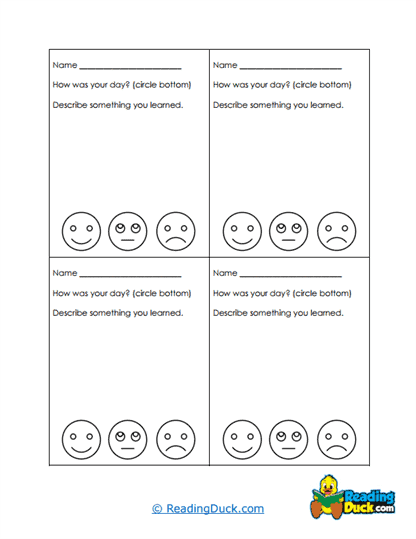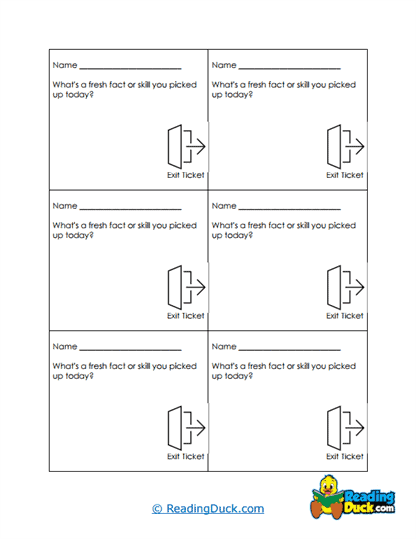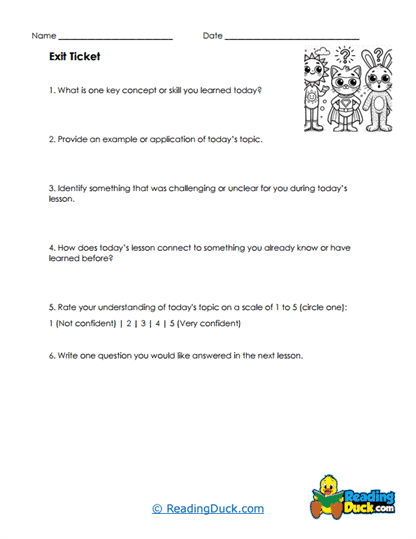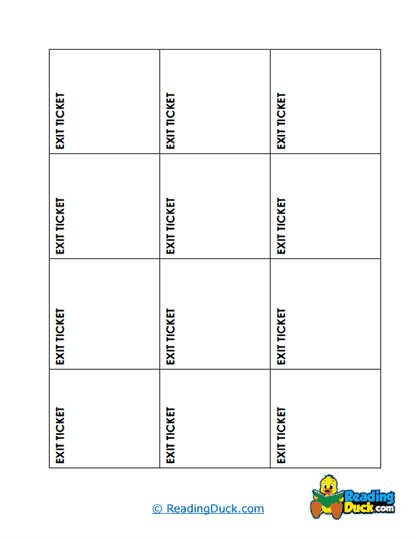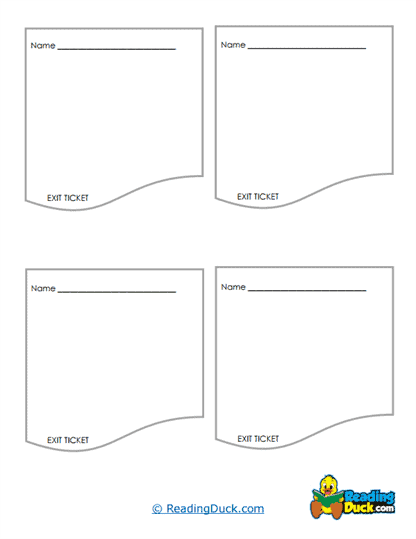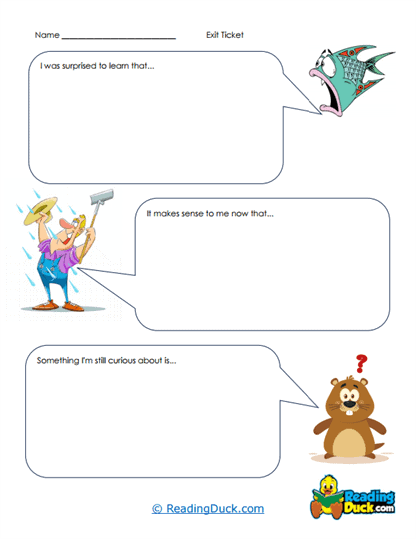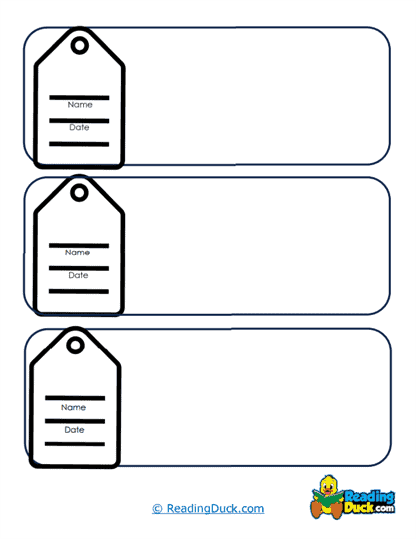Exit Tickets Worksheets
About Our Exit Tickets
Exit tickets are valuable, quick tools for formative assessment that teachers use at the conclusion of a lesson or class period. These activities typically consist of students responding to a specific prompt or question designed to assess their understanding of the day’s content. They can take various forms, such as a written response on paper, a submission via a digital platform, or a brief note in a designated notebook. By incorporating exit tickets into their instructional practices, teachers create a consistent opportunity to engage students in reflecting on their learning and identifying areas that may require further clarification.
The primary goal of exit tickets is to gauge students' comprehension of the material presented during the lesson. These tools allow educators to quickly determine whether students grasped the core concepts or if certain topics need to be revisited. Additionally, exit tickets encourage students to actively process and summarize their learning, fostering metacognitive skills that are essential for academic success. Teachers may use a variety of prompts, such as asking students to explain a key idea, pose a lingering question, or apply a concept to a real-world situation. This variety ensures that the assessment aligns with the lesson’s objectives while keeping students engaged.
Beyond assessing student understanding, exit tickets serve as a vital source of feedback for teachers themselves. By analyzing student responses, educators gain insight into the effectiveness of their teaching strategies, the clarity of their explanations, and the engagement level of their class. This immediate feedback allows teachers to make informed adjustments to their future lessons, addressing gaps in understanding or revising instructional methods as needed. In this way, exit tickets not only enhance the learning experience for students but also empower teachers to continuously refine their practice.
Types of Exit Tickets
Exit tickets can take on various forms, each tailored to suit a teacher’s instructional goals and the specific needs of the lesson. The versatility of these tools allows educators to target different aspects of student learning, from comprehension and reflection to application and self-assessment. By choosing the appropriate type of exit ticket, teachers can align their assessments with the lesson objectives while maintaining student engagement and encouraging meaningful interaction with the material.
One common type of exit ticket focuses on reflection questions, prompting students to think critically about their learning experience. For example, students might be asked, “What was the most important thing you learned today?" or “What questions do you still have about today's topic?" These questions encourage learners to evaluate what they’ve absorbed and identify areas of uncertainty. Reflection-based exit tickets are particularly effective for fostering metacognition, helping students develop the ability to analyze their own learning processes and progress.
Other types include skill demonstrations, where students apply their newly acquired knowledge in a practical way. For instance, solving a math problem tied to the day’s lesson or summarizing a text in one sentence provides teachers with immediate insight into whether students can perform specific tasks. Similarly, open-ended prompts such as “Explain how you would solve this problem differently next time" allow students to explore alternative methods or deepen their critical thinking skills. For quick feedback on content mastery, teachers might use multiple-choice questions or polls as exit tickets, where students can answer predefined questions. Another option, rate-your-understanding scales, lets students self-assess their confidence in the material, marking their understanding on a scale from 1 (not confident) to 5 (very confident). This variety ensures that exit tickets remain flexible and relevant to diverse instructional goals, making them a cornerstone of effective teaching.
Benefits for Teachers
Exit tickets offer a range of benefits for teachers, making them a powerful tool for enhancing instruction and supporting student learning. One of the most significant advantages is their ability to assess student understanding. By reviewing responses, teachers gain immediate insights into how well students have grasped the lesson objectives. This enables them to pinpoint which concepts require reteaching or reinforcement, ensuring that gaps in understanding are addressed promptly. Exit tickets act as a quick diagnostic tool, helping educators maintain alignment between teaching goals and student progress.
Another critical benefit is that exit tickets provide data for differentiation, enabling teachers to cater to the diverse needs of their students. By analyzing the responses, educators can group students based on their levels of understanding and tailor their instruction accordingly. For instance, students who demonstrate strong mastery might engage in enrichment activities, while those who need additional support can receive targeted interventions. This strategic use of exit ticket data ensures that instruction is both personalized and effective, optimizing learning outcomes for all students.
In addition to assessing student learning, exit tickets offer valuable feedback on teaching strategies. Teachers can use the information to evaluate the effectiveness of their methods, identifying which approaches resonated with students and which need refinement. Furthermore, exit tickets help uncover common misconceptions, allowing teachers to address misunderstandings before introducing new material. Beyond these instructional benefits, exit tickets contribute to classroom management and closure by providing a structured end-of-class activity. This not only reinforces the day’s learning but also creates a smooth transition to the next task or class, fostering a sense of organization and continuity in the learning environment.
Benefits for Students
Exit tickets provide numerous benefits for students, supporting their learning experience in meaningful and practical ways. One of the key advantages is the promotion of active reflection, encouraging students to think critically about what they have learned and how well they understood the material. This practice fosters metacognitive skills, enabling students to evaluate their progress, recognize areas for improvement, and take greater ownership of their learning journey.
Another benefit of exit tickets is their ability to foster increased engagement in the classroom. Knowing they will need to complete an exit ticket at the end of the lesson motivates students to stay attentive and involved throughout. This expectation helps keep students focused, as they anticipate demonstrating their understanding or contributing their thoughts. Additionally, exit tickets provide an opportunity for expression, offering a safe and structured way for students to share any confusion, pose questions, or articulate their ideas-particularly valuable for those who may feel hesitant to speak up during class discussions.
Exit tickets also contribute to confidence building by helping students clarify their understanding of the material. Through this process, they can identify what they have mastered and pinpoint areas where they need further support. This clarity empowers students, allowing them to feel more secure in their abilities while actively seeking help for challenges they encounter. Furthermore, exit tickets create a feedback loop, as students indirectly see the impact of their responses when teachers revisit concepts or adjust instruction based on their input. This reinforces the value of their participation and emphasizes the collaborative nature of learning, where their voices play a crucial role in shaping the educational experience.
Practical Tips for Effective Exit Tickets
Implementing exit tickets effectively requires thoughtful planning and execution to maximize their benefits for both teachers and students. One practical tip is to keep it brief. Exit tickets should require only a few sentences or a short task to complete, ensuring they respect time constraints at the end of class while still providing meaningful insights. Simplicity in design allows students to focus on their responses without feeling rushed, and teachers can review them quickly and efficiently.
Another important consideration is to be clear when providing instructions. The prompts or questions should be concise, easy to understand, and directly aligned with the lesson objectives. A well-crafted question guides students to reflect on specific concepts or skills, ensuring that their responses offer valuable information about their understanding. To maintain student interest and cater to diverse learning preferences, it is helpful to mix it up by using a variety of formats, such as written reflections, multiple-choice questions, or creative tasks like drawing diagrams or crafting a one-sentence summary.
To maximize the effectiveness of exit tickets, it is crucial to use the results proactively. Teachers should analyze student responses promptly and integrate the findings into their instructional planning, addressing any misconceptions or adjusting lesson pacing as needed. Incorporating technology can further enhance this process. Leveraging tools like Google Forms, Kahoot, or learning management systems simplifies the collection, organization, and analysis of exit ticket data. These platforms streamline the workflow, allowing teachers to focus on interpreting responses and making informed decisions to support student learning. By following these practical tips, educators can ensure that exit tickets remain an impactful and efficient part of their teaching toolkit.

